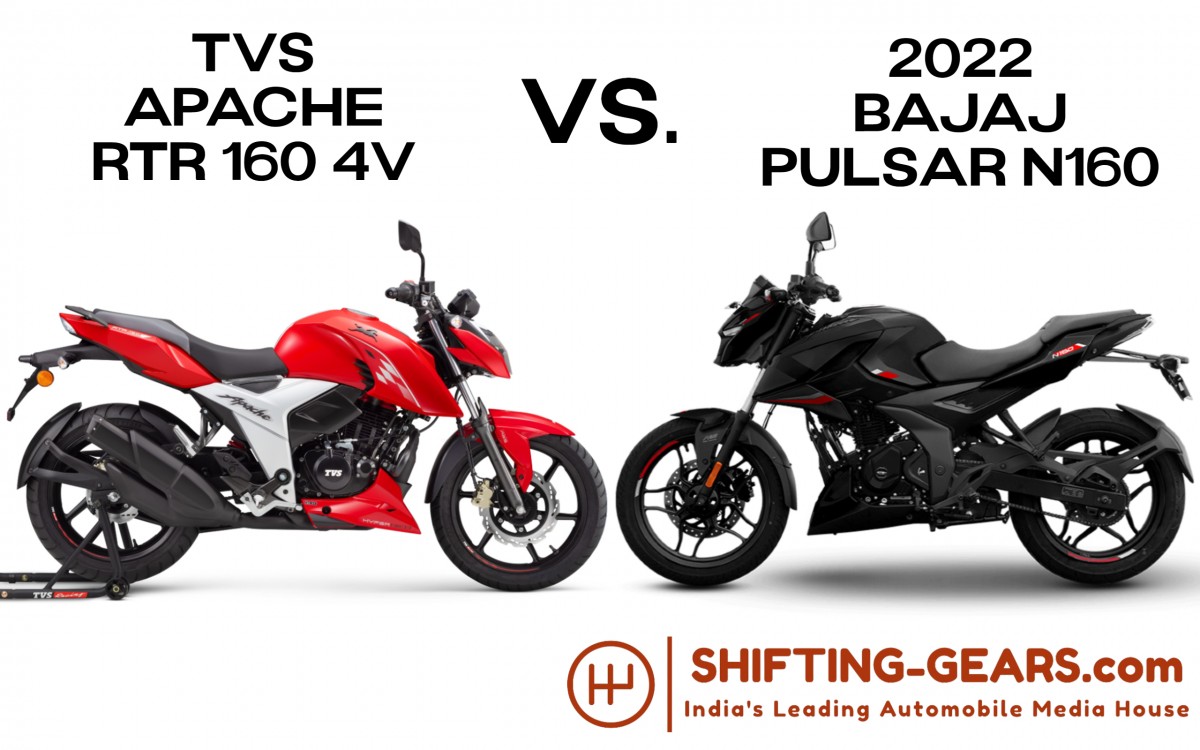

Bajaj has just introduced the newest next-generation Pulsar, the Pulsar N160. The new 160cc model will join the 250s in the Pulsar lineup. Previously, the only 160cc Pulsar that was available was the NS160. The NS platform is an older generation one. Hence, with the new platform, new looks, and segment-first and segment-best features, the Pulsar N160 is back to take on the competition.
One of the most popular choices in the 160cc segment has been the TVS Apache RTR 160 4V. Like the new Pulsar N160, the Apache RTR 160 4V also benefits from its bigger sibling in the lineup, the Apache RTR 200 4V. One of the major advantages it gets from the bigger sibling is the 4-valve setup. So far, TVS has been one of the top picks in the segment. In this specification comparison, we pin the two together so that you can decide which of the two would be a top pick for you.
The 2022 Bajaj Pulsar N160 is available in two variants – Dual Channel ABS and Single Channel ABS. The Pulsar N160’s Dual Channel ABS feature is also a segment-first. The Dual Channel ABS variant is available only in one colour option – Brooklyn Black. The Pulsar N160 with Dual Channel ABS retails at INR 1,27,853 ex-showroom Delhi. On the other hand, the Single Channel ABS variant is available in three colours – Caribbean Blue, Racing Red and Techno Grey. This variant does not get the Brooklyn Black colour option. The Pulsar N160 with Single Channel ABS comes with a price tag of INR 1,22,854 ex-showroom Delhi.
On the other hand, the Apache RTR 160 4V is available in four variants – Drum, Disc, BT Disc and Special Edition. Except for the Special Edition, all the other variants are available in three colour options – Racing Red, Metallic Blue and Knight Black. Meanwhile, the Special Edition gets a matte Knight Black colour. The Special Edition also comes with Red-coloured alloy wheels and adjustable brake and clutch levers. The pricing for the TVS Apache RTR 160 4V starts at INR 1,20,728 for the Drum variant. Meanwhile, the Disc and BT Disc variants cost INR 1,22,835 and INR 125,551 ex-showroom Delhi. At the same time, the top-end Special Edition gets a price tag of INR 1,26,925 ex-showroom Delhi.
Powering the Bajaj Pulsar N160 is a 164.82cc oil-cooled twin-spark fuel-injected motor. The single-cylinder engine also gets a 2-valve SOHC valvetrain. The motor produces 16 PS of power at 8750 rpm and 14.65 Nm of torque at 6750 rpm. Bajaj claims the N160 offers a wide torque band, which is more than any other bike in its segment. As for the gearbox, it uses a constant-mesh 5-speed unit. Furthermore, Bajaj claims it has the fastest in-gear acceleration times in 3rd, 4th and 5th gear from 30 to 70 kmph. The brand also claims a best-in-class gear shifting feel.
At the same time, the TVS Apache RTR 160 4V uses a 159.7cc oil-cooled single-cylinder engine. Unlike the Pulsar N160, the TVS offers a 4-valve SOHC valvetrain. The fuel-injected motor produces a peak power of 17.55 PS at 9250 rpm and 14.73 Nm of torque at 7250 rpm. The TVS Apache RTR 160 4V also gets three Ride Modes – Rain, Urban and Sport. In the Urban and Rain mode, the motor produces 15.64 PS at 8600 rpm and 14.14 Nm at 7250 rpm. The ride modes feature is segment-first. The bike uses a 5-speed gearbox.
The Bajaj Pulsar N160’s variants have a different setup at the front. The Dual Channel ABS variant uses 37mm telescopic forks, while the Single Channel ABS variant uses 31mm telescopic forks. However, both the variants get a Nitrox monoshock rear suspension. Bajaj also claims the Dual-Channel ABS variant’s front suspension is the best-in-class.
As for the braking hardware, the Pulsar N160 Dual Channel ABS variant uses a best-in-class 300mm front disc brake. Meanwhile, the Single Channel ABS variant uses a 280mm front disc. Both the variants use a 230mm rear disc brake. The Pulsar N160 rides on 100/80 section front and 130/70 section rear tyres.
The TVS Apache RTR 160 4V’s suspension setup consists of telescopic forks at the front and a monoshock at the back. As for brakes, it uses a 270mm petal disc at the front and a 200mm petal disc at the rear. The bike is also available with a 130 mm drum rear brake.
Compared to the Pulsar N160, the Apache RTR 160 4V rides on a smaller 90/90 section front tyre. However, it uses an identical 130/70 section tyre at the rear as the Pulsar N160.
Bajaj has not revealed the length, width and height of the Pulsar N160, but we expect it to be similar to the Pulsar N250. We do know the Pulsar N160 sports a wheelbase of 1358 mm and a seat height of 795 mm. The ground clearance of the motorcycle is 165 mm. The Dual Channel ABS variant tips the scales at 154 kg, while the Single Channel ABS variant weighs 152 kg. The Pulsar N160 has a fuel tank capacity of 14-litre.
The TVS Apache RTR 160 4V measures 2035 mm in length, 790 mm in width and 1050 mm (without visor) in height. The Apache, at 1357 mm, has an almost identical wheelbase to the Pulsar N160. The ground clearance of the Apache RTR 160 4V is 180 mm, which is 15 mm more than the Pulsar N160. Meanwhile, Apache RTR 160 4V’s seat height, at 800 mm, is 5 mm more. The Drum variant of the Apache RTR 160 4V weighs 144 kg, while the Disc variants weigh 146 kg.
Also Read: 2022 Bajaj Pulsar N160 launched in India at INR 1,25,824